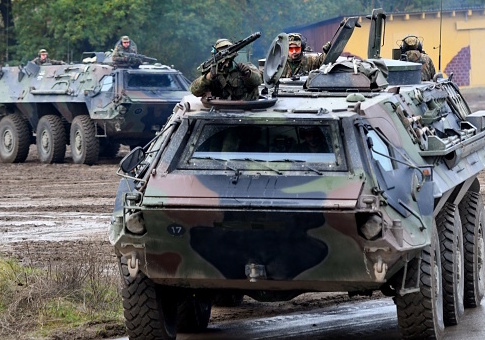In a time of increased tension between NATO countries and Russia, Germany's military faces challenges restricting its readiness on the sea, in the air, and on the land.
The German military "is currently unavailable," the Washington Post reported following an interview with Hans-Peter Bartels, a German official who acts as a political advocate for the armed forces.
Bartels said the German military is virtually "not deployable for collective defense."
Warning signs about Germany's military have existed for years, but issues with underfunding became especially visible three years ago during NATO military exercises. German soldiers at that time resorted to painting broomsticks black to give them the appearance of machine guns. Soldiers then attached them to tanks and other armored vehicles.
The practice was "incomprehensible," said a Defense Ministry spokesman.
Since then, the situation has only become worse, according to the Post. The country only has 95 combat-ready combat tanks, an issue exacerbated by the fact that Russia reportedly possesses more than 20,000.
Germany was left with only 95 Leopard 2s–the tank that is the most common in the German armed forces, the Bundeswehr– after about half went out of order in November. It is unclear how many of Russia's 20,000-plus tanks are currently operational.
And it's not just a matter of mass, but effectiveness. Germany's military vehicles have also encountered operational issues. While deployed to Mali, conditions like high temperatures and rocky terrain caused more than half of the vehicles deployed to break down, Deutsche Welle reported.
Germany's air force is not faring much better than its ground forces.
As of last April, DW reported just 38 out of 89 Tornado fighter jets, and only 25 of 57 transport jets, were ready for combat.
Defense experts caution that Germany has high standards for their equipment and may declare a tank nonoperational over something as minor as a broken blinker, according to the Post. In case of war, Germany might therefore still be able to mobilize much of its equipment. Nevertheless, Bartels said much more needs to done. The parliamentary military commissioner said decades of funding shortages are only now becoming readily apparent and the purchase of additional equipment hasn't been easy.
While the air force and military are struggling, the country's navy is facing the most significant challenges of all.
Reports came out in October that Germany's entire submarine fleet was out of commission, and an ambitious plan for a comprehensive warship that could have revolutionized Germany's navy is mired in missed deadlines and changing designs.
The F125 class frigate was an idea that began in 1997 when officials began to formulate a plan to replace the F122 Bremen Class frigates.
Four F125 frigates were ordered, costing an initially projected $2.44 billion in total. But the project soon ran into trouble. In 2003, the ship was intended to have the capability of confronting the Russian navy in the Baltic Sea. But designs changed in 2005 to focus on land attacks, specifically the delivery of soldiers into combat, the Wall Street Journal reported. That change was a mistake as the ship was not designed with sonar or torpedo tubes, making it vulnerable to submarine attack.
Russian submarine activity has increased recently, specifically around vital NATO undersea cables. Germany's most prominent naval project is producing a ship that struggles to react to submarine attack.
The new ship was already heavier than its predecessor, and adding additional weaponry and systems would increase its weight further. A report released in May of 2017 revealed that the ships were already overweight and listing 1.3 degrees to starboard.
It was a ship that was designed to be cutting-edge, operated by a smaller crew, and capable of delivering marines into combat. After several delays, the frigate was sea-ready in 2016. However, after testing, the German Navy announced it would not commission the vessel in December 2017, and the ship would undergo further construction.
Its future is now unclear. The project is already behind schedule, and a microcosm of Germany's larger military problems.
In addition to equipment problems, the Bundeswehr is experiencing personnel shortages as it transitions from a conscription-based military to a volunteer-based one.
The Post notes that German Defense Minister Ursula von der Leyen has backed increases in military spending and expansion during her term, but Bartles argues it hasn't been enough to stop the decline in military readiness.
"The hard currency, which should be used to measure the success of the minister, is the Bundeswehr’s readiness for action," said Bartels. "And this readiness has not improved over the last four years but has only gotten worse."
